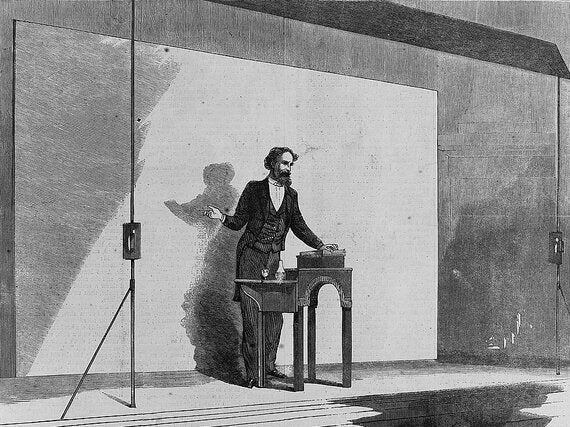
*Rebekah Scheuerle [2013] is President of the Gates Cambridge Scholars Council and is doing a PhD in Chemical Engineering. Picture credit: Charles Dickens public reading by Charles A. Barry [Public domain], via Wikimedia Commons.
"There are only two types of speakers in the world. 1. The nervous and 2. Liars." - Mark Twain
Fear of public speaking is ubiquitous, even expected. It's so common that as many as 75% of people may suffer from it. Some rankings indicate it is more prevalent than fear of airplanes or heights. An ongoing debate questions whether it may be more common than the fear of death.
Regardless of whether one fears public speaking, there are methods for improving one's technique.
The Gates Cambridge Learning for Purpose programme provides speaker training to scholars to provide strategies for improving the content and delivery method of talks. For a recent workshop, we hosted Katerina Biliouri, TEDGlobal Curation Assistant and speaker coach, who taught us numerous clever tips to improve public speaking quality. Whether your next presentation is in the boardroom, or a scientific conference, her universal principles can be applied to any talk.
Connect with your audience
Katerina emphasised the importance of connecting personally with your audience through your talk. To do this she suggested several strategies. Ensure your content is accessible, and that even complex principles are made clear. Metaphors and visual language facilitate this. Asking the audience to imagine themselves in various situations within a landscape you paint in your talk is also a highly effective method of achieving this.
You can use slides to help your audience visualise and connect to your topic as well, but don't feel obligated to have them. If choosing between one slide and none, it is better to go with none. If you do use them, they can be handy tools to remind yourself of your content, but don't put too much content on each slide. One point per slide is appropriate. You want your audience to keep their attention on you, and not your slide deck.
These aren't the only ingredients to connectedness with your audience. Authenticity, vulnerability, integrity and passion give you that important human element that makes the audience trust you and want to listen further.
Shape your talk with intentionality
Think about your ending before you begin. What is that final sentence? How do you want your audience to react? Are you seeking funding? Spreading awareness for a cause? Katerina says ending your talk with a call to action gives your presentation an afterlife of purpose. It pulls your audience as individuals into your topic and can empower them on a personal level.
Without a strong starter, though, you'll lose your audience before they are called to act! Katerina emphasised the importance of the first 30 seconds, when your audience decides if they even want to listen. She suggested using a catchy intro to kindle the listeners' curiosity.
Shaping your talk to an archetype (monomyth, narrative, etc.) can give the body structure, or you can invent one of your own. A structure that catapults your audience between the status quo and what could be (with or without) a phenomenon you are presenting can be powerful. If your talk is long, try keeping your audience engaged by building new beginnings into your talk at strategic points.
Finally, don't worry about stage fright
This isn't a flaw; it means you care! Perhaps it's your own perfectionism causing you to be nervous. Don't forget, you are the only one who knows your talk. If you scramble some points, or skip a section, only you will know.
If you are nervous you might forget important details, keep notecards in your back pocket. This safety net may make you feel more confident, even if you don't use them. Planting a familiar face in the audience to encourage you with their smile can help as well. Even practising among distractions, like in a busy room, or in front of the television, is handy. This helps you rehearse pushing through your content even when your mind is elsewhere, as it may be when you give your talk.
Lastly, don't let stage fright scare you out of using pauses. Silence gives your audience a chance to process your ideas, and adds powerful emphasis and structure to your content.
So next time you give a talk, don't fret when everyone pulls out his or her phones while you are speaking. If you are using Katerina's tips, they won't be sending emails, they'll be live tweeting your powerful message.
